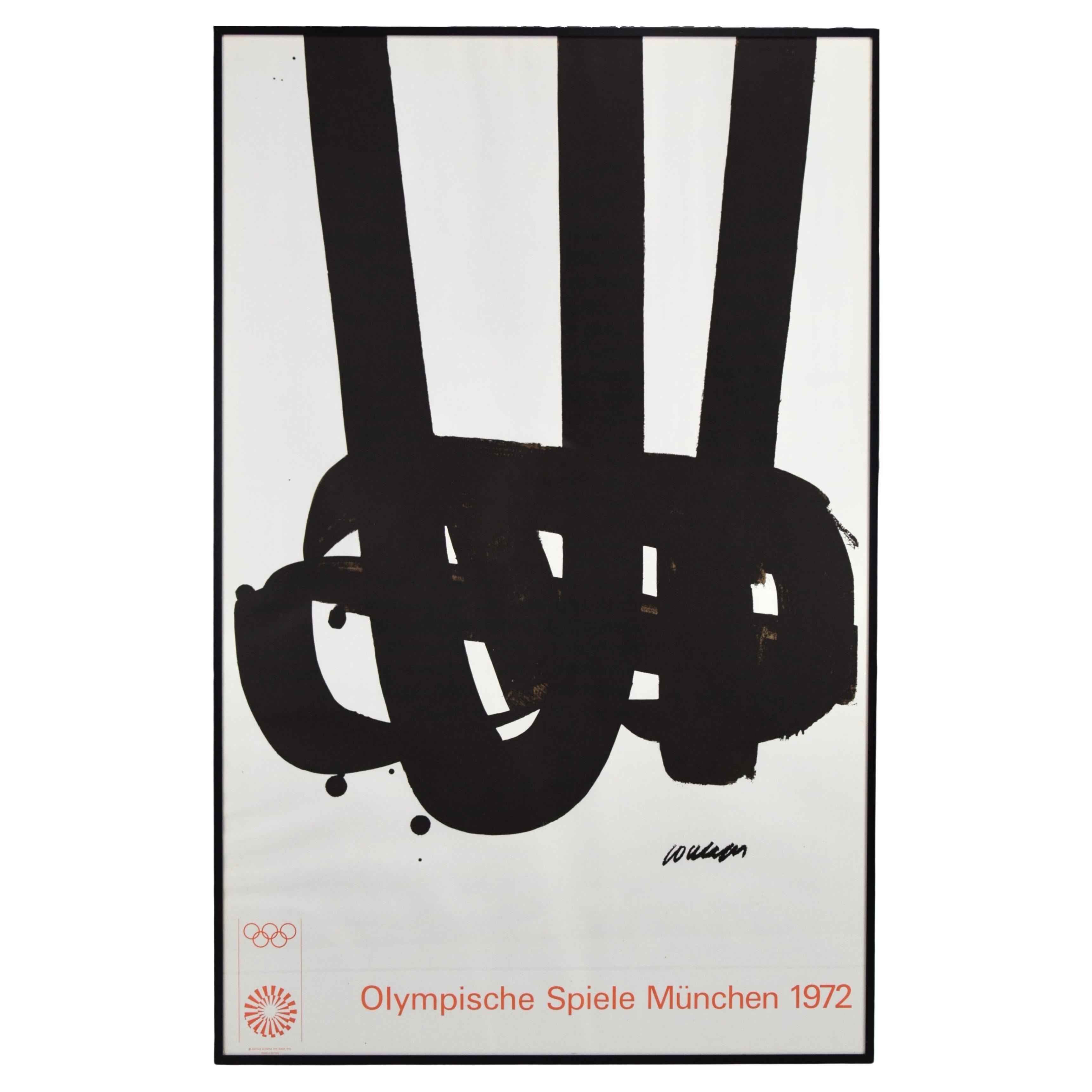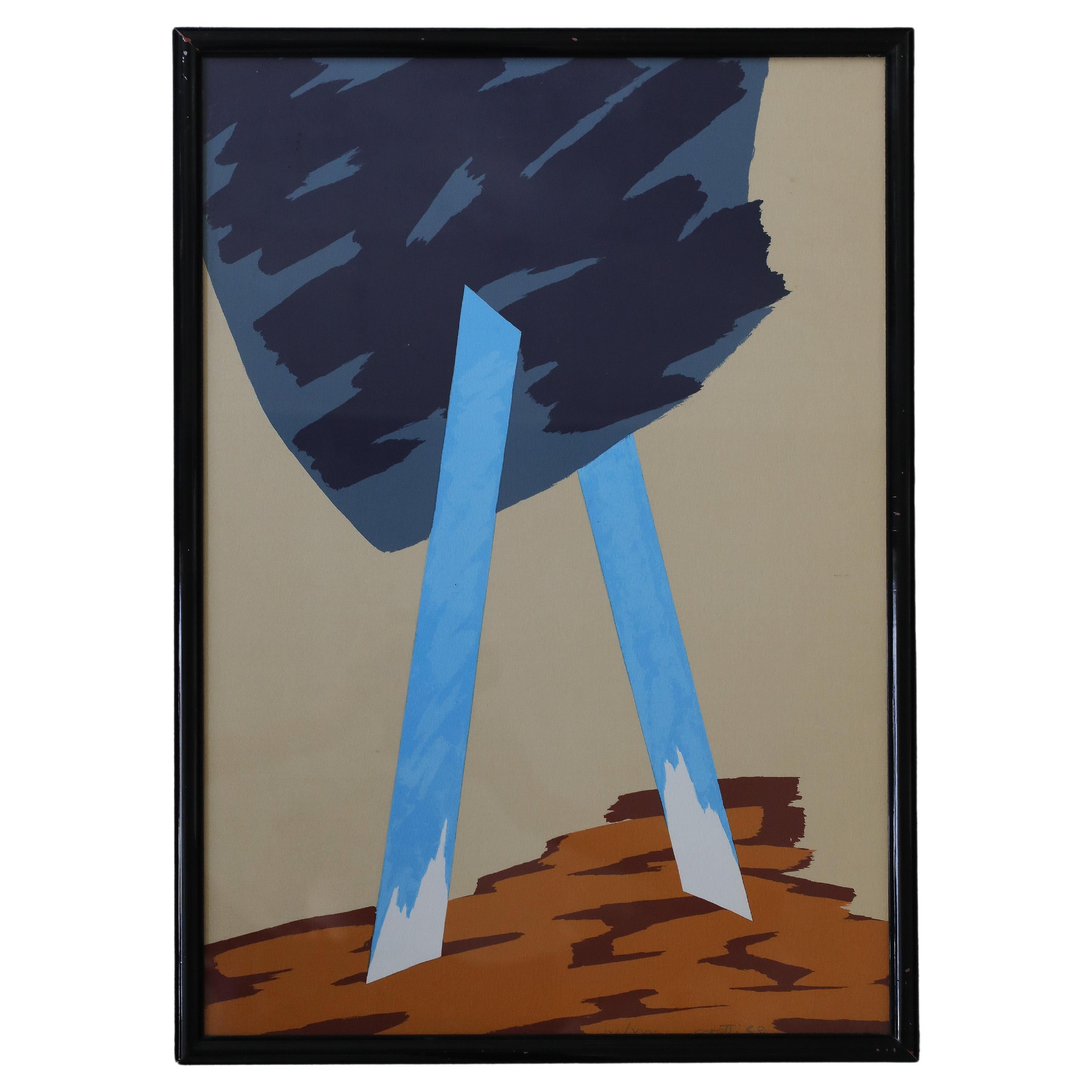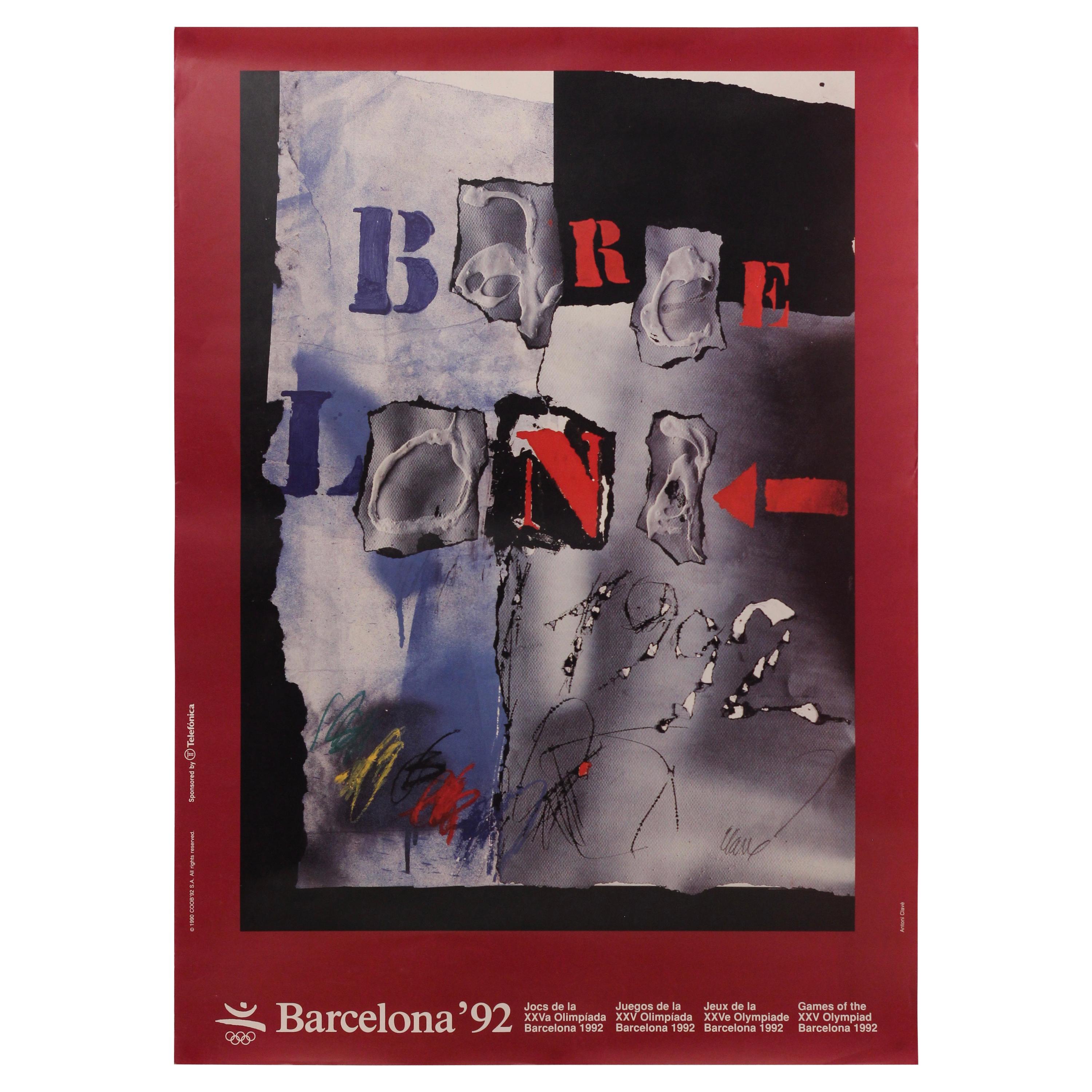Original Serigraph by Pierre Soulages, 1988, "Seregrapie Olympiad 24 Korea
About the Item
- Creator:Pierre Soulages (Artist)
- Dimensions:Height: 39 in (99.06 cm)Width: 31 in (78.74 cm)Depth: 0.07 in (1.78 mm)
- Materials and Techniques:
- Period:1980-1989
- Date of Manufacture:1988
- Condition:
- Seller Location:Phoenix, AZ
- Reference Number:1stDibs: LU1875334291372
Pierre Soulages
Pierre Soulages was born on December 24, 1919, in Rodez, France. Attracted by Romanesque art and prehistory at a young age, he began to paint. At 18, he was admitted to the École Nationale Supérieure des Beaux-Arts in Paris, but, convinced of the mediocrity of the education there, refused to enter. In 1946, Soulages began to paint fulltime. In 1948, he took part in exhibitions in Paris and elsewhere in Europe, including “Französische abstrakte malerei” (French abstract painting) in several German museums. He was the youngest of this group. In 1949, Soulages received a solo exhibition at the Lydia Conti gallery in Paris and group exhibitions in New York, London, Sao Paulo and Copenhagen. From 1949 to 1952, he created his first etchings. His group exhibitions in New York began traveling to other American museums, including “Advancing French Art” (1951), “Younger European Artists” Guggenheim Museum (1953), and “The New Decade,” Museum of Modern Art (1955). He also began to exhibit at the Kootz Gallery, New York, and the Galerie de France, Paris. In the early 1950s, his works were acquired by The Phillips Collection, Washington, D.C.; the Guggenheim Museum and the Museum of Modern Art, New York; the Tate Gallery, London, the National Museum of Modern Art, Paris; and the Museu de Arte Moderna, Rio de Janeiro, among others. In 1960, the Kestner Gesellschaft in Hanover, Germany, held Soulages’ first retrospective. Several retrospectives followed, including the Museum of Fine Arts in Houston (1966). In 1979 Soulages exhibited his first single-pigment paintings based on the reflection of light by the surface states of black at the Musée National d’Art Moderne—Centre Georges Pompidou. The pictorial light arising from the difference between two darknesses in the paintings carried a great power of emotion and possibilities for development. It was later called "black-light" and "outrenoir." Soulages has since created other works where rhythm, space and light are born from the violent contact of black and white on the canvas surface . In 2001, Soulages was the first living artist invited to exhibit at the Hermitage Museum in Saint Petersburg, then at the Tretyakov Gallery in Moscow. In October 2009, the Centre Pompidou presented the largest retrospective since the beginning of the 1980s devoted to a living artist, occupying more than 2,000 square meters of space. It ranked as the fourth most attended exhibition in the history of the Centre Pompidou. That same year, the Louvre Museum exhibited a painting by Soulages in the Salon Carré in the Denon wing. In 2019, in homage to the artist for his 100th birthday, numerous events were organized in France and abroad. The Soulages exhibition at the Louvre, designed as a mini-retrospective, presented three new paintings and was accompanied by a hanging at the Musée Natinal d’Art Moderne—Centre Georges Pompidou. Today, Soulages is represented in more than 110 museums with more than 230 paintings. He is a favorite painter among his peers, French artists.
- ShippingRetrieving quote...Ships From: Phoenix, AZ
- Return PolicyA return for this item may be initiated within 14 days of delivery.
- Victor Vasarely Original Serigraph, Circa 1970, "Juggler"By Victor VasarelyLocated in Phoenix, AZVictor Vasarely (1906-1997) Original Serigraph circa 1970 - "Juggler" Pencil signed lower right and numbered lower left. 240 of the edition of 250. Image: 25.88 x 15.88 inches. Pap...Category
Late 20th Century Prints
MaterialsPaper
- Tom Robertson Original Serigraph, circa 1940s, "Flight"By Tom RobertsonLocated in Phoenix, AZThomas Arthur Robertson color serigraph titled “Flight.” This print is in excellent condition with strong fresh color. It’s an edition of 43 and was created, circa 1940s. Signed in ...Category
Mid-20th Century Prints
MaterialsPaper
- Victor Vasarely Signed Original Serigraph, Circa 1970's - Composition CinetiqueBy Victor VasarelyLocated in Phoenix, AZWonderful serigraph in color on black light cardboard, created circa 1970's. By French/Hungarian artist Victor Vasarely, considered the father of Op Art. This work is in excellent co...Category
Vintage 1970s Prints
MaterialsPaper
- Corita Kent Original Serigraph Vietnam War Protest, "Wouldn't You Go to Jail.."By Corita KentLocated in Phoenix, AZOriginal serigraph by Sister Mary Corita Kent (1918-1986). Sheet size: 25"h x 30"w. Titled “Would You Go to Jail if it Would End the War? Quote by activist Daniel Ellsberg. Important & rare serigraph protesting the Vietnam war. Signed lower right in ink. Ca. 1971 Loosely tipped onto a black mat board measuring 26 x 31 inches. Neither matted nor framed. In excellent condition with no damage. Sister Corita Kent (1918-1986) was a nun and art teacher at Immaculate Heart College in Los Angeles. Her departure from the school (and the order) in 1968, was partially related to tension between the order and the church over the progressive reforms of the Vatican II movement, but it was also timed with her own artistic commitments and rising renown. Throughout the 1960s, she made radio and TV appearances and lectured around the country. Before Warhol made the medium famous, she was working in serigraphy (screen-printing) because it could be cheaply mass-produced and widely disseminated. Her lively, colorful works speak through graphic simplicity as they combine Bible verses, brand logos, literary quotes, and even Beatles lyrics...Category
Late 20th Century Prints
MaterialsPaper
- Dorr Bothwell, California Surrealist, Serigraph Titled "Ideograph"By Dorr BothwellLocated in Phoenix, AZCalifornia modernist Dorr Bothwell (1902-2000) original serigraph. Signed in pencil lower right and dated 1946. Edition size is also seen in pencil lower right: 8 of 35. Pencil titled lower left: "Ideograph" Framed under glass and in excellent condition. Measures: Image: 9 x 12. Frame: 16.5 x 19. Dorris Hodgson Bothwell, known as Dorr, was born in San Francisco, 1902. The Bothwell family moved to San Diego in 1911, where they became friends and neighbors with the artists Anna and Albert Valentien. Dorr began her art studies with Anna in 1916 at the age of 14. In the early 1920s, Dorr returned to San Francisco to study at the California School of Fine Arts, then studied at the University of Oregon, in Eugene, and the Rudolph Schaeffer School of Design, which was founded in San Francisco, 1926. Returning to San Diego in 1931, Dorr became involved, once more, with the San Diego art Community and exhibited with the San Diego Moderns...Category
Mid-20th Century Prints
MaterialsPaper
- Norma Bassett Hall Serigraph, Pencil Signed, SanctuarioBy Norma Bassett HallLocated in Phoenix, AZNorma Bassett Hall (1889 - 1957) Original Serigraph, created circa 1940's. Pencil titled lower left “Sanctuario.” Pencil signed lower right. Measures 12 x 15 ½ inches. Sheet size is 14 5/8 x 17 3/4 inches. In very good condition consistent with age. The woodblock presents in a 2 ply 20 x 24 inch museum mat. Most remembered as a printmaker and one of the founding members of the Prairie Printmakers...Category
Vintage 1940s Prints
MaterialsPaper
- Pierre Soulages Original 1972 München Olympic PosterBy Pierre SoulagesLocated in Weesp, NLImmerse yourself in the spirit of sport and art with the iconic 1972 München Olympic Poster created by the celebrated artist Pierre Soulages. This poster not only commemorates the hi...Category
Vintage 1970s French Mid-Century Modern Posters
MaterialsPaper
- Lithographie De Pierre SoulagesBy Pierre SoulagesLocated in PARIS, FRLithographie numero 33, 1974 Lithographie sur papier vélin d'arches Epreuve d'artiste d'une édition à 95 exemplaires Justifié au crayon "epreuve d'artiste" en bas à gauche Signée au crayon en bas à droite Exposition: Soulages l'oeuvre imprimé, edition Bibliotheque nationale de France, du 27 mai au 31 aout 2003. Une autre épreuve d'artiste exposée sous le n°82...Category
Vintage 1970s European Mid-Century Modern Paintings
MaterialsPaper
- Mino Ceretti, Color Serigraph, 1988, FramedLocated in Warszawa, MazowieckieMino Ceretti, 1988 Serigraphy Number IV/XXX The work signed by the artist's signature, individual number and date (pencil) Work dimensions 51/37 The work is framed Mino Ceretti was ...Category
Vintage 1980s Italian Mid-Century Modern Prints
MaterialsPaper
- Original Barcelona Olympic 1992 Poster 'Olympiad Xxv' Designed by AddisonLocated in London, GBThe 1992 Summer Olympics, officially known as the games of the XXV Olympiad and commonly known as Barcelona '92, were an international multi-sport event held from 25 July to 9 August...Category
1990s Spanish Modern Posters
MaterialsPaper
- Original Barcelona Olympic Poster by Antoni Clavé for the XXV OlympiadLocated in London, GBAntoni Clavé (5 April 1913 – 1 September 2005) was a Catalan master painter, printmaker, sculptor, stage designer and costume designer. He was nominated for two Academy Awards (Best Art Direction and Best Costume Design) for his work on the 1952 film Hans Christian Andersen. Clavé was one of Spain's best known and most celebrated artists. His work evolved from a baroque, ornamental style to a pure, minimal aesthetic. In his later years, his work is completely abstract, employing expressive lines and exploring the boundaries of collage, objet trove, shading, texture and color. He was trained at the School of Fine Arts, Barcelona, where he was taught by Angel Ferrant and Felix Mestres. With his works being influenced by artists such as Bonnard, Vuillard and Roualt. He is best known for his lyrical abstractions, works which combine paint with collage. Clavé fought in the Republican Army in the Spanish Civil War, and served as draughtsman for the Republican government. He arrived in France as a refugee in 1939 and went straight to Paris to work as an illustrator. His first one-man exhibition was held at the Au sans Pareil bookshop, 37 Avenue Kleber in Paris in 1940, where Max Ernst and other leading figures from the Dada movement had their first exhibitions in the 1920s. In 1944 Clavé met Picasso and began making figure compositions that were deeply influenced by Picasso's work, featuring kings, harlequins, children, and still lives. His theatrical designs have appeared on stages in New York, Munich, London and Paris, as well as in the 1952 film Hans Christian Andersen. His works include sets for opera, theatre, and ballet, most notably for Roland Petit's ballet company, Les Ballets des Champs Elysees (1945-1951) including Los Caprichos (1946) Carmen (1949) and a comic ballet choreographed by Roland Petit called Deuil en 24 Heures.In 1951 he designed La maison de Bernarda Alba (The House of Bernarda Alba) for director Marcel Achard at the Theatre de l'Oeuvre in Paris, and in 1962, a production of The Marriage of Figaro for Maurice Sarrazin at Théatre de la cour de l'Archeveché in Aix-en-Provence. In 1957 Clavé began to design carpets and from 1960 he began to work on sculptural bas reliefs...Category
1990s Spanish Modern Posters
MaterialsPaper
- Original Barcelona 1992 Olympic Poster by Antonio Saura for the XXV OlympiadBy Antonio SauraLocated in London, GBHe began painting and writing in 1947 in Madrid while suffering from tuberculosis, having already been confined to his bed for five years. In his beginnings he created numerous drawings and paintings with a dreamlike surrealist character that most often represented imaginary landscapes, employing a flat smooth treatment that offers a rich palette of colors. He claimed Hans Arp and Yves Tanguy as his artistic influences. He stayed in Paris in 1952 and in 1954–1955 during which he met Benjamin Péret and associated with the Surrealists, although he soon parted with the group, joining instead the company of his friend the painter Simon Hantaï. Using the technique of scraping, he adopted a gestural style and created an abstract type of painting, still very colorful with an organic, aleatory design. The first appearances in his work of forms that will soon become archetypes of the female body or the human figure occur in the mid-1950s. Starting in 1956 Saura tackled the register of what will prove to be his greatest works: women, nudes, self-portraits, shrouds and crucifixions, which he painted on both canvas and paper. In 1957 in Madrid he founded the El Paso Group and served as its director until it broke up in 1960. During this period Saura met Michel Tapié. During the 1950s he had his first solo exhibition at the Rodolphe Stadler Gallery in Paris, where he regularly exhibited throughout his life. Stadler introduced him to Otto van de Loo in Munich and Pierre Matisse in New York City, both of whom exhibited his work and represented him, and eventually his paintings were collected by major museums. Limiting his palette to blacks, grays and browns, Saura asserted a personal style that was independent of the movements and trends of his generation. His work followed in the tradition of Velasquez and Goya. Starting in 1959 he began creating a prolific body of works in print, illustrating numerous books including Cervantes's Don Quijote, Orwell's Nineteen Eighty-Four, Nöstlinger's adaptation of Pinocchio, Kafka’s Tagebücher, Quevedo’s Three Visions, and many others. In 1960 Saura began creating sculptures made of welded metal elements which represented the human figure, characters and crucifixions. In 1967 he settled permanently in Paris, and joined the opposition to Francoist Spain. In France he participated in numerous debates and controversies in the fields of politics, aesthetics and artistic creation. He also broadened his thematic and pictorial register. Along with his Femmefauteuil (literally "Womanarmchair"), he also worked on the series "Imaginary Portraits",and Goya’s Dog...Category
1990s Spanish Modern Posters
MaterialsPaper






